【资格考试】2019最新整理--(备考辅导)考研英语阅读理解精读100篇unit7
考研英语阅读理解精读100篇_Unit

新东方出版的考研英语阅读理解精读100篇共有25个单元,本文档包含第一个单元,更多英语考研信息请点击UNIT ONETEXT ONETesco is preparing a legal battle to clear its name of involvement in the dairy price-fixing scandal that has cost consumers £270 million. Failure to prove that it had no part in collusion with other supermarkets and dairy processors may land it with a fine of at least £80 million. The Office of Fair Trading (OFT) said yesterday that Asda, Sainsbury’s and the former Safeway, plus the dairy companies Wiseman, Dairy Crest and Cheese Company, had admitted being in a cartel to fixprices for milk, butter and cheese. They were fined a total of just over £116 million as part of a leniency deal offered by the watchdog to companies that owned up quickly to anti-competitive behaviour.Officials at the OFT admitted privately that they did not think they would ever discover which company or individual had initiated the pricing formula. But the watchdog recognises that at the time supermarkets were under pressure from politicians and farmers to raise the cost of milk to save dairy farming, though it is not certain that money found its way to farmers. The OFT claimed in September that it had found evidence that the retail chains had passed future milk prices to dairy companies, which then reached a fixed price among themselves.The average cost to each household is thought to be £11.25 over 2002 and 2003. Prices went up an extra 3p on a pint of milk, 15p on a quarter of a pound of butter and 15p on a half pound of cheese. There is no direct recompense for consumers, however, and the money will go to the Treasury. The National Consumer Council gave warning that the admissions would dent consumer confidence in leading high street names and that people would become sceptical of their claims. Farmers For Action, the group of farmers that has led protests over low milk prices since 2000, is seeking legal advice on whether it can now bring a claim for compensation.The OFT investigation is continuing, however, in relation to Tesco, Morrisons and the dairy group Lactalis McLelland, and any legal action is expected to be delayed until that is completed.Tesco was defiant and said that it was preparing a robust defence of its actions. Lucy Neville-Rolfe, its executive director, said: “As we have always said, we acted independently and we did not collude with anyone. Our position is different from our competitors and we are defending our own case vigorously. Our philosophy is to give a good deal to customers.”Morrisons has supported the OFT in inquiries into the former Safeway business that it took over, but in a statement said that it was still making “strong representations”in its defence. A spokeswoman for Lactalis McLelland said that the company was “co-operating” with the OFT. Industry insiders suggested that the three companies were deliberately stalling the OFT investigation.Sainsbury’s admitted yesterday that it had agreed to pay £26 million in fines, but denied that it had sought to profiteer. Justin King, the chief executive, said he was disappointed that the company had been penalised for actions meant to help farmers but recognised the benefit of a speedy settlement. Asda declined to say how much it would pay in fines and also said that its intention had been to help farmers under severe financial pressure.1. From the first paragraph, we may infer that _____[A] Tesco is the most resolute among all the retailers to defend its reputation.[B] it is already proved that Tesco has colluded with Asda, Wiseman, Dairy Crest and Cheese Company in fixing the dairy price. [C] Tesco is offered a leniency deal of £80 million because of its quick response to the anti-competitive behaviors[D] Tesco is trying its best to prove its innocence of the scandal.2. Who is most probably the initiator of the pricing formula?[A] Retail chains.[B] Farmers.[C] Dairy companies.[D] Politicians3. The word “defiant”(Line 1, Paragraph 5) most probably means _____.[A] resisiting[B] angry[C] deficient[D] confident4. We may infer from Morrisons’statement that _____ [A] Morrisons turn out to be the most defentive when dealing with OFT.[B] Morrisons is reluctant to support the inquiries into the former Safeway business. [C] industry insiders suggest that Morrisons was trying to delay the OFT investigation with non-cooperation.[D] Morrisons indeed refuses to admit its involvement in the scandal.5. The writer’s attitude to Tesco can be said to be _____[A] biased.[B] objective.[C] sympathetic.[D] optimistic.篇章剖析:本文介绍了目前奶制品公司因内部设定价格而面临受到的调查和处罚的状况。
考研英语阅读理解精读100篇-UNIT 9
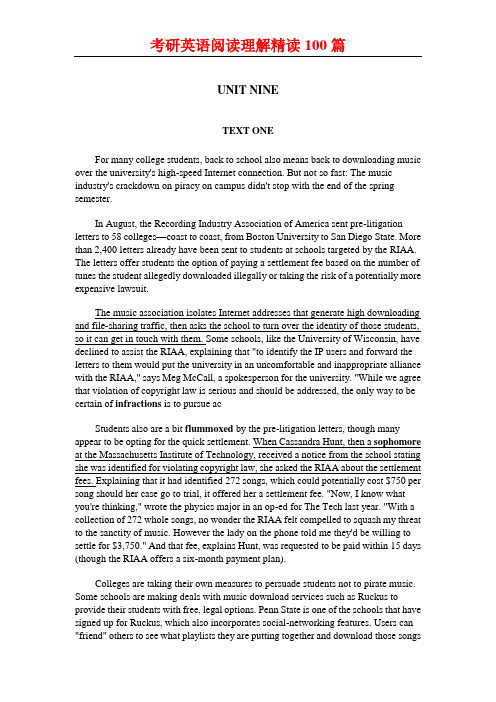
UNIT NINETEXT ONEFor many college students, back to school also means back to downloading music over the university's high-speed Internet connection. But not so fast: The music industry's crackdown on piracy on campus didn't stop with the end of the spring semester.In August, the Recording Industry Association of America sent pre-litigation letters to 58 colleges—coast to coast, from Boston University to San Diego State. More than 2,400 letters already have been sent to students at schools targeted by the RIAA. The letters offer students the option of paying a settlement fee based on the number of tunes the student allegedly downloaded illegally or taking the risk of a potentially more expensive lawsuit.The music association isolates Internet addresses that generate high downloading and file-sharing traffic, then asks the school to turn over the identity of those students, so it can get in touch with them. Some schools, like the University of Wisconsin, have declined to assist the RIAA, explaining that "to identify the IP users and forward the letters to them would put the university in an uncomfortable and inappropriate alliance with the RIAA," says Meg McCall, a spokesperson for the university. "While we agree that violation of copyright law is serious and should be addressed, the only way to be certain of infractions is to pursue acStudents also are a bit flummoxed by the pre-litigation letters, though many appear to be opting for the quick settlement. When Cassandra Hunt, then a sophomore at the Massachusetts Institute of Technology, received a notice from the school stating she was identified for violating copyright law, she asked the RIAA about the settlement fees. Explaining that it had identified 272 songs, which could potentially cost $750 per song should her case go to trial, it offered her a settlement fee. "Now, I know what you're thinking," wrote the physics major in an op-ed for The Tech last year. "With a collection of 272 whole songs, no wonder the RIAA felt compelled to squash my threat to the sanctity of music. However the lady on the phone told me they'd be willing to settle for $3,750." And that fee, explains Hunt, was requested to be paid within 15 days (though the RIAA offers a six-month payment plan).Colleges are taking their own measures to persuade students not to pirate music. Some schools are making deals with music download services such as Ruckus to provide their students with free, legal options. Penn State is one of the schools that have signed up for Ruckus, which also incorporates social-networking features. Users can "friend" others to see what playlists they are putting together and download those songsin seconds if their school has a Ruckus server installed. "We like to think of ourselves as a discovery tool," explains Charlie Moore, a senior vice president of Ruckus. But the songs downloaded can be listened to on the Ruckus player only, explains Moore. While some portable media devices can play the songs, Ruckus tunes can't be imported into iTunes or iPods. Students at Penn State also have reported some problems getting the Ruckus service to work on Apple's Mac computers. Nevertheless, that's still likely less commotion than they face from a pre-litigation letter.1. Which one of the following is not the measure taken by RIAA to fight against music piracy on campus?[A] Sending pre-litigation letters to students who have violated copyright law.[B] Blocking the access to downloading music to the students.[C] Asking schools to sign up for music download services.[D] Providing schools with charged legal access of music downloading services.2. University of Wisconsin declined to assist the RIAA because_____[A] they wanted to protect the students’privacy.[B] they thought RIAA’s request was inappropriate.[C] they considered that actions should be carried through legal procedures.[D] they did not want to made an alliance with the RIAA.3. The word “flummoxed” (Line 1, Paragraph 4) most probably means_____ [A] perplexed. [B] irritated.[C] annoyed.[D] disturbed.4. The case of Cassandra Hunt implies that _____[A] the students shows unexpected willingness to work with the RIAA on how to make the settlement fees more reasonable.[B] there exists contradiciton between RIAA’s payment plan and the actual payment requirment.[C] there exists some problems in RIAA’s acion against the students’piracy.[D] RIAA attempts to assist students by cutting off the fees and lengthen the payment period.5. About services provided by Rucks to the students, which one of the following is NOT true?[A]Those who are friended by the users of Rucks can download the songs in seconds given that both ends have access to Ruckus server.[B] Music downloaded from the Ruckus server can only be played on the Ruckus player.[C] Users can download songs freely and legally but have to face the problem of incompatibility. [D] There are some problems in playing the songs downloaded with other players.文章剖析:这篇文章讲述美国唱片产业协会对校园音乐盗版现象采取的措施。
考研英语阅读理解精读100篇:UNIT-6
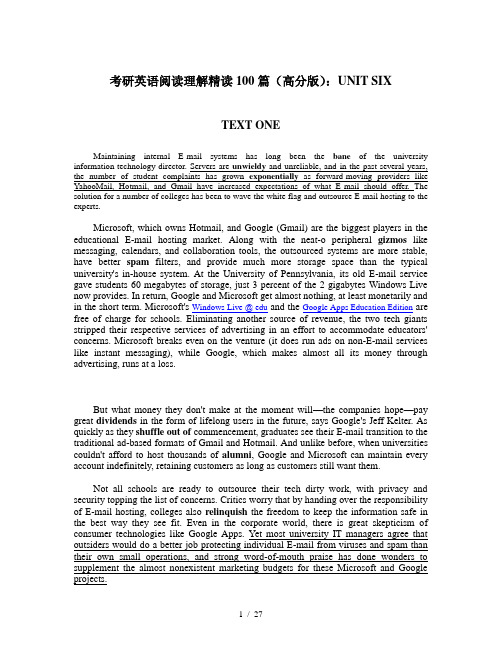
考研英语阅读理解精读100篇(高分版):UNIT SIXTEXT ONEMaintaining internal E-mail systems has long been the bane of the university information-technology director. Servers are unwieldy and unreliable, and in the past several years, the number of student complaints has grown exponentially as forward-moving providers like YahooMail, Hotmail, and Gmail have increased expectations of what E-mail should offer. The solution for a number of colleges has been to wave the white flag and outsource E-mail hosting to the experts.Microsoft, which owns Hotmail, and Google (Gmail) are the biggest players in the educational E-mail hosting market. Along with the neat-o peripheral gizmos like messaging, calendars, and collaboration tools, the outsourced systems are more stable, have better spam filters, and provide much more storage space than the typical university's in-house system. At the University of Pennsylvania, its old E-mail service gave students 60 megabytes of storage, just 3 percent of the 2 gigabytes Windows Live now provides. In return, Google and Microsoft get almost nothing, at least monetarily and in the short term. Microsoft's Windows Live @ edu and the Google Apps Education Edition are free of charge for schools. Eliminating another source of revenue, the two tech giants stripped their respective services of advertising in an effort to accommodate educators' concerns. Microsoft breaks even on the venture (it does run ads on non-E-mail services like instant messaging), while Google, which makes almost all its money through advertising, runs at a loss.But what money they don't make at the moment will—the companies hope—pay great dividends in the form of lifelong users in the future, says Google's Jeff Kelter. As quickly as they shuffle out of commencement, graduates see their E-mail transition to the traditional ad-based formats of Gmail and Hotmail. And unlike before, when universities couldn't afford to host thousands of alumni, Google and Microsoft can maintain every account indefinitely, retaining customers as long as customers still want them.Not all schools are ready to outsource their tech dirty work, with privacy and security topping the list of concerns. Critics worry that by handing over the responsibility of E-mail hosting, colleges also relinquish the freedom to keep the information safe in the best way they see fit. Even in the corporate world, there is great skepticism of consumer technologies like Google Apps. Yet most university IT managers agree that outsiders would do a better job protecting individual E-mail from viruses and spam than their own small operations, and strong word-of-mouth praise has done wonders to supplement the almost nonexistent marketing budgets for these Microsoft and Google projects.The price tag—or lack of one—isn't a bad sales pitch either. Ramin Sedehi, the vice dean for finance and administration at Penn, says 30 percent of Penn's students already forward their messages to outside clients, and he predicts universities will eventually be out of the E-mail hosting business altogether. Ball State University and the Indiana University Alumni Association are now on Windows Live, and Arizona State University switched to Google Apps in October 2006, already converting at least 40,000 of its 65,000 students to the new system. Penn State University and California Polytechnic State University, to name two, have been in talks, while other schools are watching and waiting.1. The number of student complaints has grown exponentially because_____[A] the school servers are unwieldy and unreliable.[B] the information-technology director is not the expert in providing IT-related assistance.[C] the internal E-mail systems are much more backward than those commercially successful email systems.[D] there are no collaboration tools in the internal E-mail systems.2. Microsoft and Google do not run ads on the E-mail systems for schools because_____[A] they want to cater to the requirements of their clients.[B] they are sponsored by schools and do not need the revenue from ads.[C] they want to build up a unique community with life-long loyalty.[D] they want to maintain the stability of the systems at the present.3. Compared with the universities, the advantage of Goole and Microsoft in hosting accounts of alumni is _____ [A] that they can reserve every account with minimum charge.[B] that they can retain every account at customers’ wish.[C] that they can maintain every account as long as the customers want.[D] that they can keep every account fro free ina long term.4. The two giants persist in providing the E-mail services though they run at a loss because_____[A] they believe they will have good returns from the would-be lifelong users in the future.[B] it is part of their social commitment to return the society through contributing to education.[C] their strategy is to make profit through advertisement to university alumni.[D] they want the students to propagandize for their projects.5. The word “relinquish” (Line 3, Paragraph 4)most probablymeans_____[A] lose.[B] abandon.[C] exchange. [D]waste.文章剖析:这篇文章介绍了大学将自己的电邮系统外包给微软、谷歌等公司。
【资格考试】2019最新整理-考研英语阅读理解精读100篇-模拟自测题Text4(2)

——参考范本——【资格考试】2019最新整理-考研英语阅读理解精读100篇-模拟自测题Text4(2)______年______月______日____________________部门答案:A D C B D题目分析16.答案为A,属推理判断题。
对他的名字已经比较熟悉了。
文章第一段中提到"和富有美丽的总统初选相比,在New Hampshire的州选举中,投票人对那些他们不认识的名字没有任何兴趣。
而这就是之所以Tom Alciere去年参选获胜的缘故——他曾好几次落选公职。
但那次他获得了55票而获胜。
"答案A"经过他几次的参选,人们记住了他的名字",答案B"他非常有魅力,给他的人民以魅力四射的震颤",答案C"他赞成杀死警察",答案D"他常常在投票名单上是最后一个".17.答案为D,属推理判断题。
文章第二段Mr. Alciere在选举中只是许诺为个人而奋斗,并未提到警察什么的,其实我们可以从文章分析出来,不是当时别人没有问他,而是他心里明白那会引起什么反应。
答案A"宣布所有警察该死",答案B"在广播脱口秀中发表愤怒",答案C"从未被问起过关于警察的事",答案D"和他的选民玩心计".18.答案为C,属事实细节题。
答案C"他污蔑他的选民只是为了引起人们的注意",文中并没有这一点意思。
答案A"许多选民在政府中有一定的声望",答案B"记者对他仇恨警察这件事并不以为然",答案D"'那些所谓愚蠢、肥胖、丑陋的老女人'在社会上还是有一定市场的".19.答案为B,属推理判断题。
文章第四段提到"无脑恐龙"是New Hampshire对政府蔑视的象征。
【资格考试】2019最新整理--(备考辅导)考研英语阅读理解精读100篇unit76
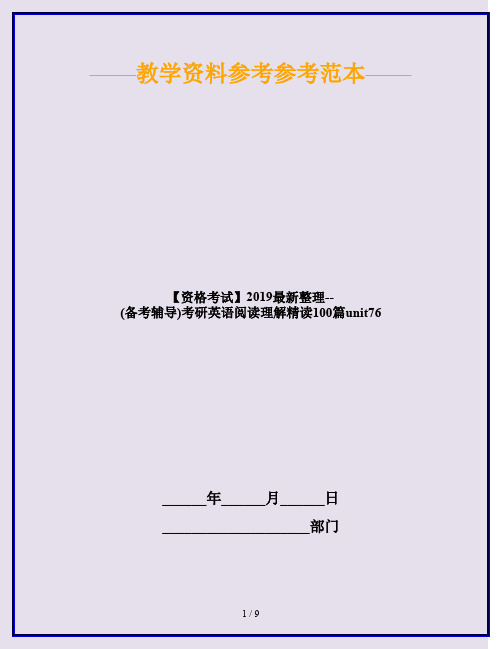
——教学资料参考参考范本——【资格考试】2019最新整理--(备考辅导)考研英语阅读理解精读100篇unit76______年______月______日____________________部门Carmen Arace Middle School is situated in the pastoral town of Bloomfield, Conn., but four years ago it faced many of the same challenges as inner-city schools in nearby Hartford: low scores on standardized tests, dropping enrollment and high rates of detention. Then the school's hard-driving principal, Delores Bolton, persuaded her board to shake up the place by buying a laptop computer for each student and teacher to use, in school and at home. For good measure, the board provided wireless Internet access at school. Total cost: $2.5 million.Now, an hour before classes start, every seat in the library is taken by students eager to get online. Fifth-grade teacher Jen Friday talks about sedimentary rocks as students view them at a colorful website. After school, students on buses pull laptops from backpacks to get started on homework. Since the computers arrived, enrollment is up 20%. Disciplinary suspensions are down 80%. Scores on state achievement tests are up 35%. Bolton, who is black, is proud to run "a school with 90% black enrollment that is on the cutting edge."Indeed, school systems in rural Maine and New York City are eager to follow Arace Middle School's example. Governor。
考研英语阅读理解精读100篇unit90

考研英语阅读理解精读100篇unit90Unit 90Watching a child struggle to breathe during an asthma attack is frightening for any parent. So it is only natural that most moms and dads will try just about anything——including spending a lot of money——to keep an attack at bay. Trouble is, more than half of parents are trying strategies that simply don't work and wasting hundreds of dollars in the process, according to a study published last week in the Journal of Allergy and Clinical Immunology.The report, based on interviews with the parents of 896 asthmatic children in 10 different cities, contained some good news. Eighty percent of parents had a handle on at least one of the triggers that worsened their children's asthma. After that, however, many parents seemed to go astray, taking precautions that weren't helpful "and made little sense," according to Dr. Michael Cabana, a pediatrician at the University of Michigan's C.S. Mott Children's Hospital, who led the study.One of the most common mistakes was to buy a mattress cover to protect against dust mites for a child whose asthma was exacerbated instead by plant pollen. Many of those parents then neglected to do what would have helped a lot more: shut the windows to keep pollen out. Another was using a humidifier for a child who was allergic to dust mites; a humidifier tends to be a place where dust mites like to breed. With those allergies, a dehumidifier works better.Worst of all was the number of smokers with asthmatic children who didn't even try to quit or at least limit themselves to smoking outdoors rather than just moving to another room orthe garage. Second-hand smoke has been proved, over and over again, to be a major trigger of asthma attacks. Many smoking parents purchased expensive air filters that have what Cabana called "questionable utility."Part of the problem, Dr. Cabana and his colleagues believe, is that parents are bombarded by television ads that encourage them to buy products such as air and carpet fresheners, ionizers and other remedies that are often expensive but medically unnecessary. And doctors may not always take the time, or have the time, to explain to parents what will and won't work in their child's particular case. For example, allergies are usually a problem for older children with asthma, while kids 5 and younger more frequently have trouble with viral respiratory infections. So make sure you understand what's really triggering your child's asthma. And remember, the best solutions are not always the most expensive ones.注(1):本文选自Time,8/30/2004,p67;注(2):本文习题命题模仿对象2004年真题T ext 11. What does the study by Dr. Michael Cabana indicate?[A]Parents are eager to cure of their children's disease.[B]Many parents are wasting money for their children's frightening disease.[C] Many parents fail to find the effective way for their children's disease.[D]Parents feel worried about their children's disease.2. Which of the following is not the trigger of asthma attacks?[A]Humidifier.[B]Second-hand smoke.[C]Plant pollen.[D]Dust mites.3. The expression “to keep an attack at bay” (Line 3, Paragraph 1) most probably means ________.[A]to ease the attack[B]to lessen the attack[C]to continue the attack[D]to prevent the attack4. Why are the parents in such a dilemma?[A]The doctors are not responsible enough.[B]Parents are influenced much by ads.[C]Parents are ignorant of the disease.[D]The quality of medical products is not good.5. Which of the following is true according to the text?[A]Parents shouldn't spend too much money on the children.[B]The expensive products are not always good.[C]To know the real trigger of the disease is very important.[D]Parents often make mistakes.答案:CADBC篇章剖析本文采用提出问题——说明问题——分析问题的模式,指出哮喘病患儿家长在防治哮喘方面存在的问题、错误及其误区。
考研英语阅读理解精读100篇-UNIT 10
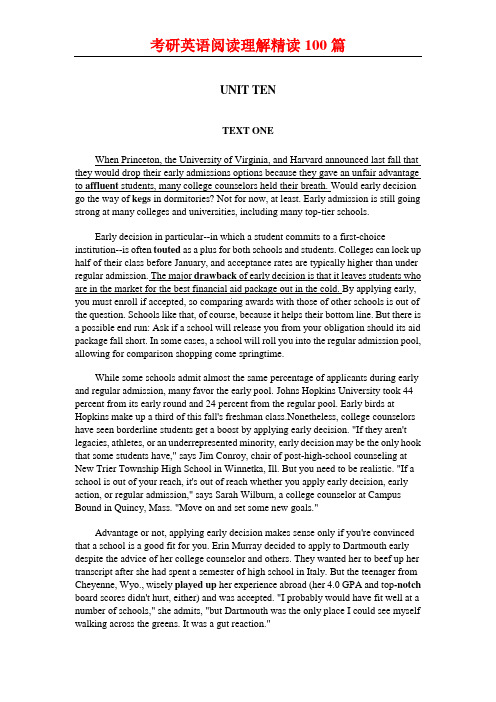
UNIT TENTEXT ONEWhen Princeton, the University of Virginia, and Harvard announced last fall that they would drop their early admissions options because they gave an unfair advantage to affluent students, many college counselors held their breath. Would early decision go the way of kegs in dormitories? Not for now, at least. Early admission is still going strong at many colleges and universities, including many top-tier schools.Early decision in particular--in which a student commits to a first-choice institution--is often touted as a plus for both schools and students. Colleges can lock up half of their class before January, and acceptance rates are typically higher than under regular admission. The major drawback of early decision is that it leaves students who are in the market for the best financial aid package out in the cold. By applying early, you must enroll if accepted, so comparing awards with those of other schools is out of the question. Schools like that, of course, because it helps their bottom line. But there is a possible end run: Ask if a school will release you from your obligation should its aid package fall short. In some cases, a school will roll you into the regular admission pool, allowing for comparison shopping come springtime.While some schools admit almost the same percentage of applicants during early and regular admission, many favor the early pool. Johns Hopkins University took 44 percent from its early round and 24 percent from the regular pool. Early birds at Hopkins make up a third of this fall's freshman class.Nonetheless, college counselors have seen borderline students get a boost by applying early decision. "If they aren't legacies, athletes, or an underrepresented minority, early decision may be the only hook that some students have," says Jim Conroy, chair of post-high-school counseling at New Trier Township High School in Winnetka, Ill. But you need to be realistic. "If a school is out of your reach, it's out of reach whether you apply early decision, early action, or regular admission," says Sarah Wilburn, a college counselor at Campus Bound in Quincy, Mass. "Move on and set some new goals."Advantage or not, applying early decision makes sense only if you're convinced that a school is a good fit for you. Erin Murray decided to apply to Dartmouth early despite the advice of her college counselor and others. They wanted her to beef up her transcript after she had spent a semester of high school in Italy. But the teenager from Cheyenne, Wyo., wisely played up her experience abroad (her 4.0 GPA and top-notch board scores didn't hurt, either) and was accepted. "I probably would have fit well at a number of schools," she admits, "but Dartmouth was the only place I could see myself walking across the greens. It was a gut reaction."If you lack the same certainty but clinching a slot before New Year's is appealing, consider other early admissions plans. Early action is a nonbinding alternative that allows you to apply by November 1 and hear back before the regular application deadline. Some highly selective schools require that you submit only one early action application--called single-choice early action--meaning you can't apply early elsewhere. Another option is to apply early to rolling admissions, where an application that arrives in the fall may stand out more than one that arrives with most of the others in January.1. Which one of the following statements is NOT true of early decision?[A] Early decision is a common strategy adopted by universities to secure high rate of student enrollment.[B] Early decision begins to be abandoned by top American universities.[C] Early decision is a special treatment for rich students, athletes and minorities.[D] Early decision will still be in practice for a fairly long time.2. The major disadvantage of early decision is that_____[A] students can enjoy a less attractive the financial aid package if he chooses early decision.[B] it excludes students who are from lower social class or poor family background.[C] it does not allow students to choose the other better schools.[D] it excludes students who want to have comparison shopping.3. What Sarah Wilburn wants to suggest students is that_____[A] early decision is not so advantageous as people think. [B] students should not regard early decision as the sole way to college.[C] students should evaluate themselves objectively before making early decision.[D] students should not limit themselves in early decision.4.Wyo applied to Dartmouthbecause_____[A] she was quite confident due to her rich experience of studying abroad. [B] the university’s beautiful lawn aroused her affection.[C] she found Dartmouth the only one that fit her after researching a bunch of universities.[D] her 4.0 GPA and top-notch board scores were not so ideal.5. The following options can be adopted by students lacking certainty of which school to apply to except_____[A] applying to early action.[B] applying to rolling admissions.[C] applying to early decision.[D] applying single-choice early action.文章剖析:这篇文章主要讲述了美国的提前择校制度。
考研英语阅读理解精读100篇
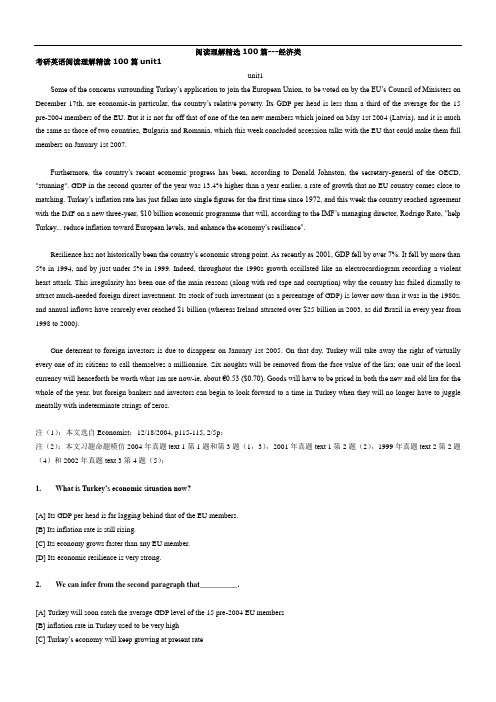
阅读理解精选100篇---经济类考研英语阅读理解精读100篇unit1unit1Some of the concerns surrounding Turkey’s application to join the European Union, to be voted on by the EU’s Council of Minis ters on December 17th, are economic-in particular, the country’s relative poverty. Its G DP per head is less than a third of the average for the 15 pre-2004 members of the EU. But it is not far off that of one of the ten new members which joined on May 1st 2004 (Latvia), and it is much the same as those of two countries, Bulgaria and Romania, which this week concluded accession talks with the EU that could make them full members on January 1st 2007.Furthermore, the country’s recent economic progress has been, according to Donald Johnston, the secretary-general of the OECD, "stunning". GDP in the second quarter of the year was 13.4% higher than a year earlier, a rate of growth that no EU country comes close to matching. Turkey’s inflation rate has just fallen into single figures for the first time since 1972, and this week the countr y reached agreement with the IMF on a new three-year, $10 billion economic programme that will, according to the IMF’s managing director, Rodrigo Rato, "help Turkey... reduce inflation toward European levels, and enhance the economy’s resilience".Resilience has not historically been the country’s economic strong point. As recently as 2001, GDP fell by over 7%. It fell by more than 5% in 1994, and by just under 5% in 1999. Indeed, throughout the 1990s growth oscillated like an electrocardiogram recording a violent heart attack. This irregularity has been one of the main reasons (along with red tape and corruption) why the country has failed dismally to attract much-needed foreign direct investment. Its stock of such investment (as a percentage of GDP) is lower now than it was in the 1980s, and annual inflows have scarcely ever reached $1 billion (whereas Ireland attracted over $25 billion in 2003, as did Brazil in every year from 1998 to 2000).One deterrent to foreign investors is due to disappear on January 1st 2005. On that day, Turkey will take away the right of virtually every one of its citizens to call themselves a millionaire. Six noughts will be removed from the face value of the lira; one unit of the local currency will henceforth be worth what 1m are now-ie, about €0.53 ($0.70). Goods will have to be priced in both the new and old lira for the whole of the year, but foreign bankers and investors can begin to look forward to a time in Turkey when they will no longer have to juggle mentally with indeterminate strings of zeros.注(1):本文选自Economist;12/18/2004, p115-115, 2/5p;注(2):本文习题命题模仿2004年真题text 1第1题和第3题(1,3),2001年真题text 1第2题(2),1999年真题text 2第2题(4)和2002年真题text 3第4题(5);1. What is Turkey’s economic situation now?[A] Its GDP per head is far lagging behind that of the EU members.[B] Its inflation rate is still rising.[C] Its economy grows faster than any EU member.[D] Its economic resilience is very strong.2. We can infer from the second paragraph that__________.[A] Turkey will soon catch the average GDP level of the 15 pre-2004 EU members[B] inflation rate in Turkey used to be very high[C] Turkey’s economy will keep growing at present rate[D] IMF’s economic program will help Turkey join the EU3. The word “oscillated” (Line 3, Para graph 3) most probably means_________.[A] fell[B] climbed[C] developed[D] swang4. Speaking of Turkey’s foreign direct investment, the author implies that_________.[A] it’s stock is far less than that of other countries[B] it does not have much influence on Turkey’s economic progress[C] steady GDP growth will help Turkey attract more foreign direct investment[D] Turkey’s economic resilience relies on foreign direct investment5.We can draw a conclusion from the text that__________.[A] foreign investment environment in Turkey will become better[B] Turkey’s citizens will suffer heavy loss due to the change of the face value of the lira[C] the local currency will depreciate with the removal of six noughts from the face value[D] prices of goods will go up答案:C B D C A篇章剖析本篇文章是一篇说明文,介绍了土耳其的经济状况。
英语阅读理解精读100篇UNIT19
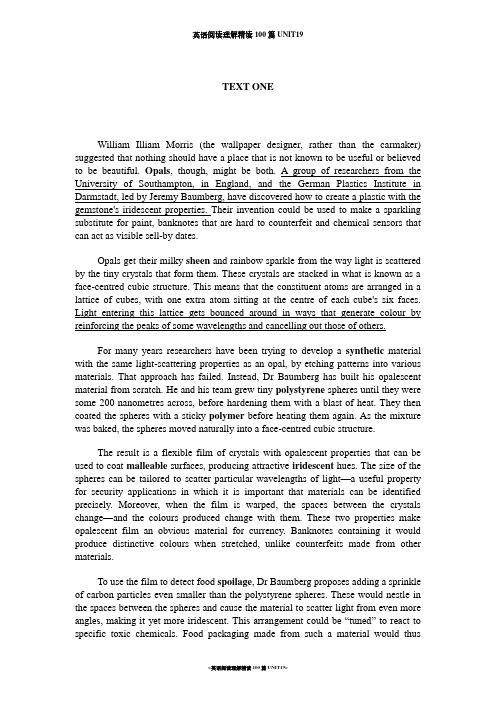
TEXT ONEWilliam Illiam Morris (the wallpaper designer, rather than the carmaker) suggested that nothing should have a place that is not known to be useful or believed to be beautiful. Opals, though, might be both. A group of researchers from the University of Southampton, in England, and the German Plastics Institute in Darmstadt, led by Jeremy Baumberg, have discovered how to create a plastic with the gemstone's iridescent properties. Their invention could be used to make a sparkling substitute for paint, banknotes that are hard to counterfeit and chemical sensors that can act as visible sell-by dates.Opals get their milky sheen and rainbow sparkle from the way light is scattered by the tiny crystals that form them. These crystals are stacked in what is known as a face-centred cubic structure. This means that the constituent atoms are arranged in a lattice of cubes, with one extra atom sitting at the centre of each cube's six faces. Light entering this lattice gets bounced around in ways that generate colour by reinforcing the peaks of some wavelengths and cancelling out those of others.For many years researchers have been trying to develop a synthetic material with the same light-scattering properties as an opal, by etching patterns into various materials. That approach has failed. Instead, Dr Baumberg has built his opalescent material from scratch. He and his team grew tiny polystyrene spheres until they were some 200 nanometres across, before hardening them with a blast of heat. They then coated the spheres with a sticky polymer before heating them again. As the mixture was baked, the spheres moved naturally into a face-centred cubic structure.The result is a flexible film of crystals with opalescent properties that can be used to coat malleable surfaces, producing attractive iridescent hues. The size of the spheres can be tailored to scatter particular wavelengths of light—a useful property for security applications in which it is important that materials can be identified precisely. Moreover, when the film is warped, the spaces between the crystals change—and the colours produced change with them. These two properties make opalescent film an obvious material for currency. Banknotes containing it would produce distinctive colours when stretched, unlike counterfeits made from other materials.To use the film to detect food spoilage, Dr Baumberg proposes adding a sprinkle of carbon particles even smaller than the polystyrene spheres. These would nestle in the spaces between the spheres and cause the material to scatter light from even more angles, making it yet more iridescent. This arrangement could be “tuned” to react to specific toxic chemicals. Food packaging made from such a material would thuschange colour as the rot set in.Such packaging need not be expensive. The polymer spheres and carbon particles arrange themselves spontaneously into the correct crystal structure when encouraged by a little heat, so manufacturing opalescent film should be easy. Indeed Merck, a German chemical company that was a partner in the research, has already produced rolls of the stuff a metre wide and 100 metres long. Perfect for wallpaper. 1.Which one of the following statement is NOT true of the opals according to the passage?[A] For years, scientists’ endeavor of imitating opals’ unique characteristics has reached to nil.[B] Opals could be brilliant mainly because they have some kind of iridescent properties.[C] Opals could be brilliant because they have tiny crystals which could scatter light.[D] Opals could be used to make a sparkling substitute for paint.2.The opalescent material that Dr Baumberg and his team have developed model itself on _____[A] the face-centred cubic structure of the opals.[B] the light scattering properties of the opals.[C] the tiny polystyrene spheres of the opals.[D] the flexible film of crystals of the opals.3.The flexible film of crystals Dr Baumberg has finally got is an ideal material for currency because _____[A] it can be used to coat malleable surfaces so that the currency could have iridescent hues.[B] the colour change as the film is bent so that the currency could be identified precisely.[C] different colours could be produced as the film could be tailored to scatter particular wavelengths of light.[D] certain colours could be made as the currency is distended so that it is easy to distinguish.4.The logic that food spoilage could be detected by use of the film is that _____[A] the carbon particles Dr Baumberg adds into the film could react to specific toxic chemicals.[B] the polystyrene spheres could scatter light from more angeles.[C] carbon particles positioned among the spheres could be adjusted to be sensitive to addled materials.[D] carbon particles added into the polystyrene spheres could make the film more iridescent.5.The film of crystals with opalescent properties can be used to make the following materials except_____[A] paint.[B] banknote.[C] chemical sensors.[D] wallpaper.篇章剖析:这篇文章讲述了人们利用蛋白石宝石闪光特性的情况。
考研英语阅读理解精读100篇(高分版) UNIT 3

UNIT THREETEXT ONEScores of workers from MTV Networks walked off the job yesterday afternoon, filling the sidewalk outside the headquarters of its corporate parent, Viacom, to protest recent changes in benefits. The walkout highlighted the concerns of a category of workers who are sometimes called permalancers: permanent freelancers who work like full-time employees but do not receive the same benefits.Waving signs that read ''Shame on Viacom,'' the workers, most of them in their 20s, demanded that MTV Networks reverse a plan to reduce health and dental benefits for freelancers beginning Jan. 1. In a statement, MTV Networks noted that its benefits program for full-time employees had also undergone changes, and it emphasized that the plan for freelancers was still highly competitive within the industry. Many freelancers receive no corporate benefits. But some of the protesters asserted that corporations were competing to see which could provide the most mediocre health care coverage. Matthew Yonda, who works at Nickelodeon, held a sign that labeled the network ''Sick-elodeon.'' ''I've worked here every day for three years -- I'm not a freelancer,'' Mr. Yonda said. ''They just call us freelancers in order to bar us from getting the same benefits as employees.'' The changes to the benefits package were announced last Tuesday. Freelancers were told that they would become eligible for benefits after 160 days of work, beginning in January. While that eased previous eligibility rules, which required freelancers to work for 52 weeks before becoming eligible, it would have required all freelancers not yet eligible for benefits to start the waiting period over again on Jan. 1. The 401(k) plan was also removed. On Thursday, acknowledging the complaints, MTV Networks reinstated the 401(k) plan and said freelancers who had worked consistently since March would be eligible.Fueled by a series of blog posts on the media Web site Gawker -- the first post was headlined ''The Viacom Permalance Slave System'' -- a loose cohort of freelancers created protest stickers and distributed walkout fliers last week. Caroline O'Hare, a unit manager who has worked for MTV for more than two years, said the new health care plan -- with higher deductibles and a $2,000 cap on hospital expenses each year -- had provoked outrage. ''They think they can treat us like children that don't have families, mortgages or dreams of retirement,'' she said.Outside Viacom's headquarters, several workers held posters with the words, ''There's too many of us to ignore.'' It was unclear how many freelancers are on the company's payroll; an MTV Networks spokeswoman said the figure was not known because it rises and falls throughout the year. The company has 5,500 full-timeemployees, excluding freelancers, around the world.Two freelancers and one full-time employee, who asked not to be identified for fear of retribution, estimated that the percentage of freelancers in some departments exceeded 75 percent. Another labor action is expected to take place outside Viacom later this week. Members of the Writers Guild of America, who have been on strike for five weeks, are expected to picket there on Thursday.1.Which one of the following statements is NOT true of MTV Networks’new benefits plan for freelancers?[A] Its benefits plan for freelancers is highly competitive in the industry.[B] Its freelancers cannot receive the same benefits as the full-time employees.[C] The freelancers who are not eligible for benefits should start the waiting period over again on Jan. 1.[D] The freelancers are against the new plan which substantially but their benefit 2. According to the new benefits program of MTV Networks, the following freelancers are eligible for benefits except_____[A] those who have worked for 160 days.[B] those who have worked for 1 year.[C] those who have worked since March.[D] those who have worked since Jan. 1.3.The word “reinstate” (Line 6, Paragraph3) most probably means_____[A] redesign.[B] restore. [C] repair.[D] reset.4. The MTV Networks spokeswoman did not provide the number of freelancers on the payroll mostly probably because_____[A] the figure fluctuates throughout the year and it is impossible to calculate the precise number.[B] the company wants to keep it as a secret so as to better stand the protest. [C] the company has no record of the freelancers since there is no such necessity.[D] the company does not want to provide the freelancers with benefits enjoyed by the full-time employee.5. Towards MTV Networks’ change on the benefits plan, the author’s attitude can be said to be_____[A] affirmative.[B] negative.[C] biased.[D] neutral.文章剖析:这篇文章介绍了MTV Networks公司修改其对于雇用的自由职员的福利待遇方案的调整以及引起的反响。
【资格考试】2019最新整理-(备考辅导)DirectionFor this part,you are allowed 30 minutes
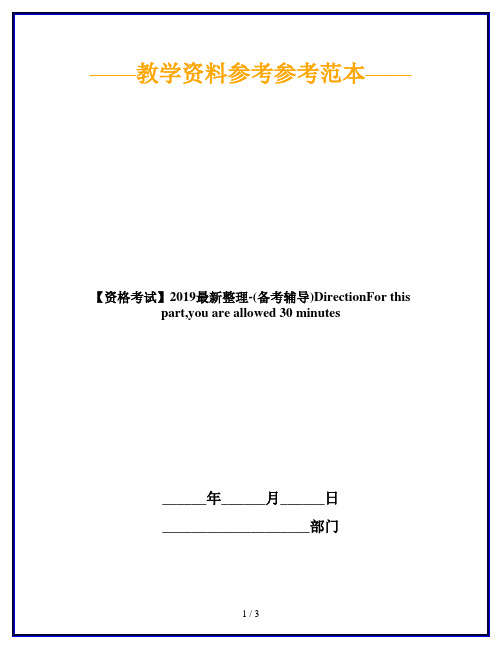
1. Housing problem comes hand in hand with population growth.
2. Despite the mushrooming high building,the provision or short of demands.
Various solutions have been suggested.But there seems to be a drawback to each of the solutions.The traditional freeallocation of dwellings to the needy brings great economic burden to the government, while paid allocation brings equal burden to the average people. The moving of urban population to the suburbs may ease housing problem in inner city but brings about traffic problem.The best solution seems to be a combination of all suggeted solutions.We still have a long way to go.
3.Various solutions have been suggested.
Example
Housing problem comes hand in hand with population growth. Some big cities in China are now encumbered with a rising population. Naturally,one of the most serious problems incurred is that of housing. Despite the mushrooming high building,the provision of living space still falls far short of demands.Since the world is advancing, people are no longer reconciled to living in shabby shelters.They look forward to decent dwelling places which can protect huan dignity.
考研英语阅读理解精读100篇(高分版)UNIT 11

UNIT ELEVENTEXT ONE“WHANG—Boom—Boom—cast delicacy to the winds.” Thus Ezra Pound in a letter to his father, urging the old man to help promote his first published collection. It might have been the poet's manifesto.Pound is as divisive a figure today as he was in his own lifetime. For some he was the leading figure of the Modernist movement who redefined what poetry was and could be; and who, in his role as cultural impresario, gave vital impetus to the literary careers of T.S. Eliot, James Joyce and Wyndham Lewis, among others. But for many Pound remains a freak and an embarrassment, a clinical nutcase and vicious anti-Semite who churned out a lot of impenetrable tosh before losing the plot completely.During the second world war he broadcast pro-Fascist radio programmes from Italy and later avoided trial for treason at home only because he was declared insane. On his release from St Elizabeth's Hospital near Washington, DC, he returned to Italy (“America is a lunatic asylum”), where he died in 1972 age d 87.David Moody, emeritus professor of English at Y ork University, makes a strong case for Pound's “generous energy” and the “disruptive, regenerative force of his genius”. His approach (unlike Pound's) is uncontroversial. He follows the poet's progress chronologically from his childhood in Idaho—still, at the time of his birth in 1885, part of the wild west—to his conquest of literary London between 1908 and 1920. He marshals Pound's staggering output of poetry, prose and correspondence to excellent effect, and offers clear, perceptive commentary on it. He helps us to see poems, such as this famous, peculiarly haunting 19-syllable haiku, in a new light: The apparition of these faces in the crowd:Petals on a wet, black bough.That Mr Moody is constantly being upstaged by the subject of his study is not surprising. Pound was one of the most colourful artistic figures in a period full of them.According to Ford Madox Ford, who became a good friend of Pound's shortly after the bumptious young American arriv ed in London: “Ezra would approach with the step of a dancer, making passes with a cane at an imaginary opponent. He would wear trousers made of green billiard cloth, a pink coat, a blue shirt, a tie hand-painted by a Japanese friend, an immense sombrero, a flaming beard cut to a point and a single large blue earring.” W.B. Y eats's simple assessment was that: “There is no younger generation of poets. E.P. is a solitary volcano.”A great merit of Mr Moody's approach is the space he gives to Pound's writings. It is love-it-or-hate-it stuff, but, either way, undeniably fascinating. “All good art is realism of one kind or another,” Pound said. Reconciling that tidy statement with practically any of his poems is hard work but, as Mr Moody shows over and over again, hard work that offers huge rewards. His first volume ends in 1920, with Pound quitting London in a huff, finally fed up—after more than adecade of doing everything in his power to rattle the intellectual establishment—with “British insensitivity to, an d irritation with, mental agility in any and every form”. His disgraceful radio programmes and the full blooming of his loopiness lie ahead. So, too, do most of his exquisite Cantos.1. Pound was a divisive figurebecause_____[A] he brought both positive andnegative effect to the developmentof the Modernist movement. [B] he was both a poet and a person withmental problem.[C] he was politically a racist while hewas also pro-Fascist.[D] he was a man of complex andunintelligible personality.2. When Pound was released from hospital, he returned to Italy because_____[A] Italy was his hometown.[B] he was persecuted by Americans.[C] he disliked America.[D] he was out of his mind.3. Which one of the following statements is NOT true of David Moody‟s study on Pound?[A] His literary approach is unlike that of Pound‟s, being less contradictory. [B] He focuses on Pound‟s poetry itself instead of his personality, attempting to keep objective[C] He traces the poet‟s life in time order to study Pound‟s ac hievement.[D] His study offers a fresh sight of Pound…s work4.From Keats‟s simple assessment, it can be inferred that_____[A] Pound was of exploding power inhis literary creation.[B] Pound‟s achievement could hardly be reached by later poets.[C] Pou nd‟s excellence was unsurpassable in his time.[D] It would take a long time forPound‟s generation to fully understand him.5. The word “rattle”(Line 6, Paragraph 7) most probably means _____[A] set up.[B] destroy.[C] struggle.[D] disturb.文章剖析:这篇文章主要介绍了Pound的两个不同侧面。
考研英语阅读理解精读100篇(高分版):UNIT_7
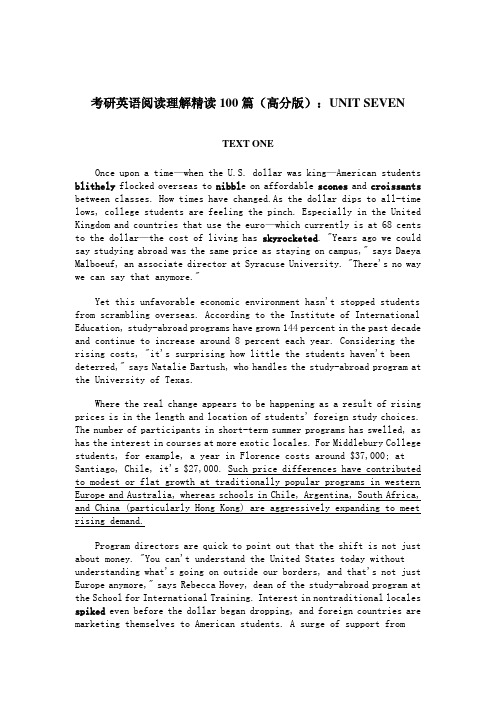
考研英语阅读理解精读100篇(高分版):UNIT SEVENTEXT ONEOnce upon a time—when the U.S. dollar was king—American studentsblithely flocked overseas to nibbl e on affordable scones and croissantsbetween classes. How times have changed.As the dollar dips to all-timelows, college students are feeling the pinch. Especially in the UnitedKingdom and countries that use the euro—which currently is at 68 centsto the dollar—the cost of living has skyrocketed. "Years ago we couldsay studying abroad was the same price as staying on campus," says DaeyaMalboeuf, an associate director at Syracuse University. "There's no waywe can say that anymore."Yet this unfavorable economic environment hasn't stopped studentsfrom scrambling overseas. According to the Institute of InternationalEducation, study-abroad programs have grown 144 percent in the past decadeand continue to increase around 8 percent each year. Considering therising costs, "it's surprising how little the students haven't beendeterred," says Natalie Bartush, who handles the study-abroad program atthe University of Texas.Where the real change appears to be happening as a result of risingprices is in the length and location of students' foreign study choices.The number of participants in short-term summer programs has swelled, ashas the interest in courses at more exotic locales. For Middlebury Collegestudents, for example, a year in Florence costs around $37,000; atSantiago, Chile, it's $27,000. Such price differences have contributedto modest or flat growth at traditionally popular programs in westernEurope and Australia, whereas schools in Chile, Argentina, South Africa,and China (particularly Hong Kong) are aggressively expanding to meetrising demand.Program directors are quick to point out that the shift is not justabout money. "You can't understand the United States today withoutunderstanding what's going on outside our borders, and that's not justEurope anymore," says Rebecca Hovey, dean of the study-abroad program atthe School for International Training. Interest in nontraditional localesspiked even before the dollar began dropping, and foreign countries aremarketing themselves to American students. A surge of support fromeducation nonprofits and the State Department also has fueled the trend.Study-abroad costs also vary wildly based on the way colleges structure their programs. Schools that effectively swap students with a foreign college are less affected by the falling dollar, but American schools that operate their own student centers often end up paying more for rent, utilities, and faculty salaries as the U.S. currency falters. The dollar's slide also means that trying to set student fees in advance is a tiresome guessing game for college officials. Most of these educators' energy, however, is spent scrounging up extra financial aid for needy travelers. Students already getting help can usually transfer their aid to tuition and fees abroad, but basics like housing and food are often at the mercy of the fluctuating dollar. Airfare, which can exceed $1,000 round trip, is not generally included in school fees, and whirlwind trips across continents are rarely cheap.The emphasis on student financial responsibility is especially evident at private schools like Syracuse, which charges the same pricey tuition abroad as at home. Even at more affordable public universities and private colleges like Middlebury—which charges U.S. students the often cheaper tuition of the international host schools—counselors are quick to peddle the virtue of thrift, a lesson no longer lost between those on safety and culture shock.1. The fact that American students blithely flocked overseas to nibble on affordable sconesa and croissants implies that_____[A] studying abroad cost almost the same as staying in U.S. for higher education.[B] American students were encouraged to study overseas to enrich their experience.[C] the cost of living at abroad was moderate for American students.[D] the U.S. dollar was the strongest currency in the world. 2. The changes of study-abroad caused by the dollar’s depreciation are the following ones except_____[A] students’ enthusiasm of studying abroad in short period does not disappear but vice versa.[B] students become hesitant when considering long-term overseas programs.[C] programmes in western Europe and Australia suffer declining popularity.[D] students who chose to study at certain continents are at a rapid growth.3. Rebecca Hover’s statement implies that_____[A] the United States are now more readily influenced by the other countries than before.[B] shift in the mainland may also be caused by factors outside of America.[C] Europe can no longer influnece the United States as before.[D] the United States are extending its influence beyond its boraders.4. Who are probably most affected by the dollar’s dip?[A] The international exchange students. [B] The students who have got scholarships.[C] The students at costly private schools.[D] The students at public universities.5. The best title for this passage is_____[A] Impact of the Dollar’s Devaluation.[B] American Students at Abroad.[C] Study-abroad Costs for American Students.[D] Shift of American Students’Foreign Study.文章剖析:这篇文章主要讲述美元贬值后对于美国学生留学的影响。
【资格考试】2019最新整理-(备考辅导)[双语阅读] 海疆行(一)
![【资格考试】2019最新整理-(备考辅导)[双语阅读] 海疆行(一)](https://img.taocdn.com/s3/m/d7f1458833d4b14e852468d6.png)
王淵源:横にあるあの橋は何?
韓佳:中朝友好橋よ。韓佳:って見てみましょう。王淵源:よし。
韓佳:この中朝友好大橋は12桁鋼構造の大橋で、断橋と百メートルも離れていません。断橋と併せて鴨緑江の姉妹橋と呼ばれています。中朝両国の交通の要所ね。
王淵源:いつ開通したのかな?
韓佳:1909年8月に建てられたの。単線鉄道橋で全部で12桁、中国側6桁、朝鮮側6桁だったのよ。
王淵源:今残っているのは4桁だけだけど、当時は雄大な橋だったのが今でも見て取れるね。
韓佳:ええ、そうね。
王淵源:なら元々この橋の上が中朝両国の国境線だったわけだね。
韓佳:鴨緑江に国境線は引けなくても、橋には引けたのね。
韓佳:对。
王渊源:那江对面就是朝鲜喽。
韓佳:没错儿。对面就是朝鲜的第二大城市——新义州。哎,我说王渊源,你今天怎么这么兴奋啊。
王渊源:中朝的界河鸭绿江名气那么大。我今天第一次亲眼看到,我能不兴奋嘛。
韓佳:断橋が見えてきたわ。断橋は100年近く歴史があり、初めて鴨緑江に架けられた橋なのよ。戦争中に破壊されて、残ったのは4桁の断橋だけ、以来歴史の証人になったのよ。
王渊源:这座桥是什么时候建成通车的呀?
韓佳:是1909年8月建成的。是一座单线铁路桥,一共是十二孔,中方六孔、朝方六孔。
王渊源:虽然现在只剩下四孔,但还是能看出来 当年它是很雄伟的,对吧?
韓佳:嗯,没错儿。
王渊源:那原来在这座桥上是不是有中朝两国的国界线呢?
韓佳:鸭绿江是没有界线的,但是桥有界。
王渊源:韩佳,这是什么?
考研英语阅读理解精读100篇-UNIT 13

UNIT THIRTEENTEXT ONEOn Tuesday afternoon, as news about the Virginia Tech murders filtered out, the staff of a hamburger restaurant in downtown Austin gathered in front of a television suspended over the bar. A boyish-looking waiter speculated that if the gunman had really used a 9mm handgun, he must have had an accomplice. That handgun can hold a fair number of bullets, he said, but the gunman would have had to stop to reload.It is not unusual for a Texan to be casually conversant about firearms. A state resident does not need a permit to buy a gun and guns do not have to be registered. Police are, as a result, not sure how many guns there are in the state. But the number is substantial. In a 2001 poll by the Behavioural Risk Factor Surveillance Survey, 36% of respondents said that their household had at least one.The state's gun laws are lax, and becoming more so all the time. In March Governor Rick Perry signed a bill into law that gives increased discretion to open fire. Previously, Texans were justi fied in killing someone only if “a reasonable person in the actor's situation would not have retreated”. The new law, which takes effect in September, eliminates the need for escape attempts. It assumes that the otherwiselaw-abiding citizen had a good reason for standing their ground. It also gives shooters immunity from civil suits.The law has plenty of critics. Law-enforcement officials say the duty to retreat saves lives because it discourages people from escalating conflicts. The new law seems to protect hysterical trigger-fingers who feel themselves genuinely threatened when no real threat exists. The law was probably not necessary anyway. There is no carjacking crisis in the state. And juries have never been sticklers about the duty to retreat. There is widespread sympathy for the idea that, as Oliver Wendell Holmes put it in 1921, “Detached reflection cannot be demanded in the presence of an uplifted knife.”Still, the bill flew through the legislature with broad support. In a way, it simply marks a return to form for the state. Texas did not acknowledge a duty to retreat until 1973. And Texas is just the 16th state to pass such legislation since Florida did so in 2005. Florida's law goes even further, as it presumes that any cat burglar has murderous intent.Texans largely support gun ownership, despite the fact that the state has experienced mass murders of its own. In 1966 Charles Whitman, a student at the University of Texas at Austin, shot almost 50 passers-by from the top of the campus clock-tower. Sixteen died. And in 1991 George Hennard drove his truck into arestaurant in the small town of Killeen, where he killed 23 patrons before killing himself. Before this week, those episodes were, respectively, the deadliest campus shooting and the worst mass shooting in America's history.1. The waiter speculated that the murderer must have had an accomplice because_____[A] the murderer was too young to commit such a serious murder by himself.[B] the murderer need an aid to reload bullets for him.[C] the murderer need someone to carry the weapon for him.[D] the murderer was instigated by some behind the curtain.2. Which one of the following statements is TRUE of the bill signed by the governer?[A] The bill could better safeguard the law-abiding citizen.[B] The bill will encourage people to use guns more frequently.[C] The bill will make the gun laws of Texas more lax.[D] The bill will prevent gun owners from all civil suits.3.Towards the new gun law of Texas, the law-enforcement officials’ at titude can be said to be_____ [A] supportive.[B] opposing.[C] indifferent.[D] unclear.4. The idea conveyed by Oliver Wendell Holmes’ statement is _____[A] that people will naturally resist when feeling threatened.[B] that people will need to protect themselves when facing crisis.[C] that people naturally feel threatened even there is no real danger.[D] that people will retreat when founding the danger.5. Which one of the following is TRUE of Texa’s law?[A] Texas is the 16th state to pass the duty to retreat through the legislature.[B] Texas’ new law won broad support from gun owners.[C] Florida’s law goes too far away when compared with the new law of Texas.[D]The new law was passed quite smoothly.文章剖析:这篇文章讲述了德克萨斯州的枪支法律。
- 1、下载文档前请自行甄别文档内容的完整性,平台不提供额外的编辑、内容补充、找答案等附加服务。
- 2、"仅部分预览"的文档,不可在线预览部分如存在完整性等问题,可反馈申请退款(可完整预览的文档不适用该条件!)。
- 3、如文档侵犯您的权益,请联系客服反馈,我们会尽快为您处理(人工客服工作时间:9:00-18:30)。
——教学资料参考参考范本——【资格考试】2019最新整理--
(备考辅导)考研英语阅读理解精读100篇unit7
______年______月______日
____________________部门
The Indian finance ministry's mid-year review, released this week, sees the external sector as a silver lining
around the country's huge fiscal deficit. “Buoyant” and “encouraging” are the words used to describe three consecutive quarters of current-account surplus——the first
in a quarter-century. Add to that swelling foreign-exchange reserves and a stronger rupee, and some are arguing that it
is time for drastic liberalisation of India's foreign-exchange regime. They could be disappointed.
For most of the past decade, the nominal value of the rupee has been allowed to decline gently against the dollar,
by about 5% a year, thus staying fairly steady in real terms. This year, however, it has been appreciating in real terms (and, since June, nominally as well)。
It would have done so more sharply had the central bank not been buying dollars with gusto. Exporters of manufactured goods, obsessed with price competition from China, are aghast at the rise——and
at the prospect held out by some forecasters that a sustained boom in India's IT exports means it will continue.
The rupee's recent strength is only partly related to
India's prowess in software and the mushrooming of
“business-process outsourcing” in such projects as call-。
